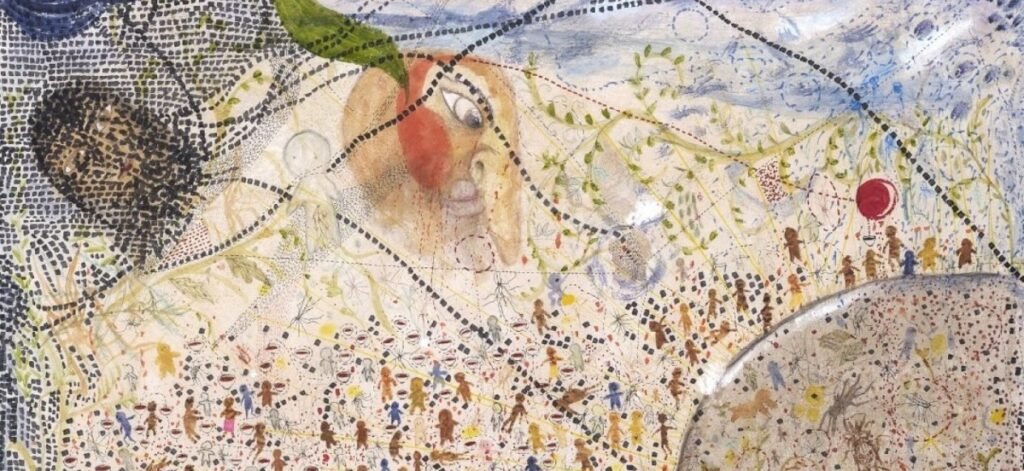Returning to the basics of art and drawing holds immense importance in understanding the essence of artistic expression, a timeless language that transcends epochs and cultures. Titik Garis Bentuk: Drawing as Practice at Ilham Gallery, Kuala Lumpur, beautifully underscores this significance by delving into the most fundamental and universal form of human expression.
According to gallery director Rahel Joseph, one of the reasons they put this exhibition together was to explore the role drawing plays in contemporary practice in Malaysia as well as its place as an art form in its own right. All of the 27 Malaysian artists featured in the show have used it as a primary medium in their work.
“When coming up with the list of artists/works, we knew we wanted to show a diverse range of practice — from figuration and landscape to architectural diagrams, minimalism and drawing as a meditative practice. We also desired to show the different ways artists were approaching drawing, from the scale of Ahmad Zakii Anwar’s life-sized portraits to the intimacy of emerging artist Binti’s diaristic narratives.
“We didn’t want to restrict ourselves to conventional concepts of drawing but instead wanted to explore the different ways in which artists were approaching it, from the use of animation and gaming software to cement and embroidery,” she explains.
Within this show, a diverse array of artworks that challenge the conventional distinctions between drawing and other artistic mediums await. Among these is the installation titled Quarry by Hasanul Isyraf Idris. Evoking the appearance of a graphite hill, it comprises layers of paper meticulously coloured with graphite sticks. Through repeated application, the paper assumes a tangible texture, actively shaping the form of the artwork. Here, the paper medium transcends its typical role as a passive surface, actively contributing to the overall composition of the piece.
“Shika Thibault transforms her drawings using Pico-8 to create video games, while Haris Abadi was inspired by children’s illustrations to create his video ABC Atas Pasar. In Chang Yoong Chia’s Quilt of the Dead, an ongoing collaboration conceived as a way of remembering the deceased, he embroidered, freehand, hundreds of portraits of the departed onto pieces of cotton.”
On March 30, Chang gave a full-day performance at the gallery to engage the public in discussions about death and its implications on the living.
When planning the layout of the exhibition, Rahel wanted the first point of encounter to be Wong Hoy Cheong’s charcoal study of his rubber tapper grandmother. This study was first seen in Of Migrants & Rubber Trees, a seminal show of drawings and installations held at the Creative Centre of the National Art Gallery Malaysia in 1996. This body of work uses the very personal story of the artist’s Chinese immigrant family to tell the larger Malaysian story of migration, race, class and displacement.
“Like Wong, artist Novia Shin uses drawing as a way of representing and documenting the nation’s history. In her highly layered pop-up installation, she applies a comic book aesthetic to present the social history around an industrial hub located on Old Klang Road, the oldest major road in Kuala Lumpur, which runs parallel to the Klang River,” Rahel explains.
“Artist Chang Fee Ming is well known for his intricate figurative drawings. We have a selection in the exhibition which pays tribute to his home state of Terengganu, its cultural traditions and people. Similarly, artist Khairudin Zainudin recorded observations of the changes in his home state Kelantan in his Moleskine notebooks.”
Since the opening on March 24, there has been great response with more than 13,000 visitors so far, including school and college groups. Several programmes have been conducted in conjunction with the exhibition, such as talks by Pusaka founder and director Eddin Khoo and historian Ong Kar Jin, and workshops on travel journalling to zine-making.
Upcoming activities include a lecture-demonstration by artist Jalaini Abu Hassan, a Kelantanese cooking class as well as a talk by artist Syarifah Nadhirah, the author of Recalling Forgotten Tastes, on her research into indigenous plants, and what she has learnt from the Orang Asli communities about sustainability, food and our forests.
“Act of Drawing with Jalaini, one of Malaysia’s most well-known contemporary artists, will see him performing in situ large-scale drawings in the gallery space. He will speak on material processes, form and meaning, as well as stories behind his work, Bomoh Hujan. We are also going to restart our very popular Ilham Kids Art Discovery Tours, which are designed to encourage art appreciation and creativity among children aged seven to 12.”
The ‘Titik Garis Bentuk: Drawing as Practice‘ exhibition at Ilham Gallery, Level 5, Ilham Tower, 8 Jalan Binjai, KL, ends on July 28.






